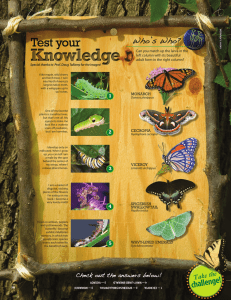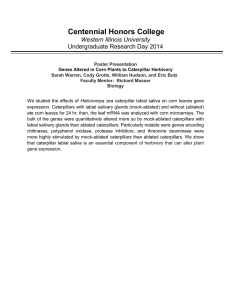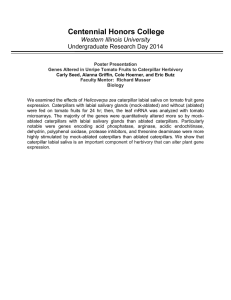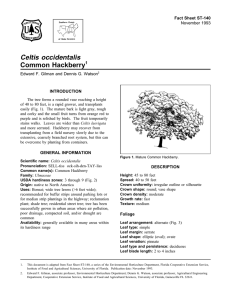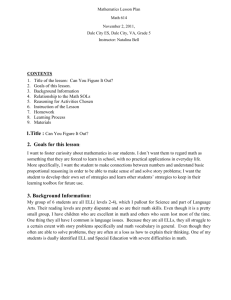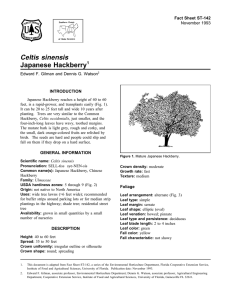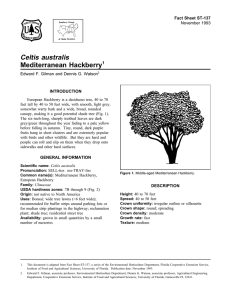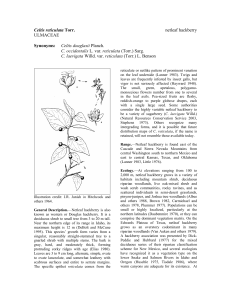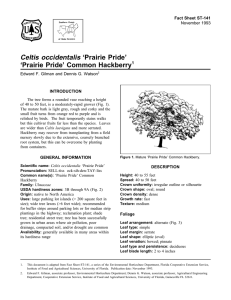C M B W
advertisement
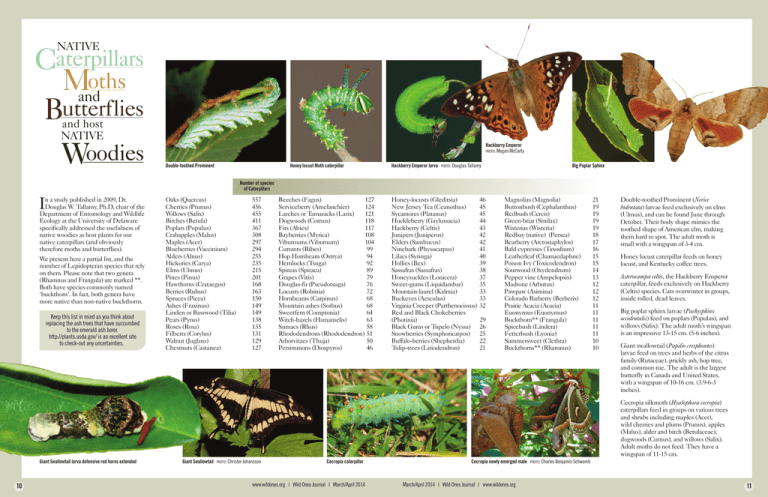
NATIVE Caterpillars Mandoths Butterflies Woodies and host NATIVE Hackberry Emperor PHOTO: Megan McCarty Double-toothed Prominent Honey locust Moth caterpillar Hackberry Emperor larva PHOTO: Douglas Tallamy Big Poplar Sphinx Number of species of Caterpillars n a study published in 2009, Dr. Douglas W. Tallamy, Ph.D, chair of the Department of Entomology and Wildlife Ecology at the University of Delaware specifically addressed the usefulness of native woodies as host plants for our native caterpillars (and obviously therefore moths and butterflies). I We present here a partial list, and the number of Lepidopteran species that rely on them. Please note that two genera (Rhamnus and Frangula) are marked **. Both have species commonly named ‘buckthorn’. In fact, both genera have more native than non-native buckthorns. Keep this list in mind as you think about replacing the ash trees that have succumbed to the emerald ash borer. http://plants.usda.gov/ is an excellent site to check-out any uncertainties. Oaks (Quercus) Cherries (Prunus) Willows (Salix) Birches (Betula) Poplars (Populus) Crabapples (Malus) Maples (Acer) Blueberries (Vaccinium) Alders (Alnus) Hickories (Carya) Elms (Ulmus) Pines (Pinus) Hawthorns (Crataegus) Berries (Rubus) Spruces (Picea) Ashes (Fraxinus) Linden or Basswood (Tilia) Pears (Pyrus) Roses (Rosa) Filberts (Corylus) Walnut (Juglans) Chestnuts (Castanea) 557 456 455 411 367 308 297 294 255 235 215 201 168 163 150 149 149 138 135 131 129 127 Beeches (Fagus) 127 Serviceberry (Amelanchier) 124 Larches or Tamaracks (Larix) 121 Dogwoods (Cornus) 118 Firs (Abies) 117 Bayberries (Myrica) 108 Viburnums (Viburnum) 104 Currants (Ribes) 99 Hop Hornbeam (Ostrya) 94 Hemlocks (Tsuga) 92 Spireas (Spiraea) 89 Grapes (Vitis) 79 Douglas-fir (Pseudotsuga) 76 Locusts (Robinia) 72 Hornbeams (Carpinus) 68 Mountain ashes (Sorbus) 68 Sweetfern (Comptonia) 64 Witch-hazels (Hamamelis) 63 Sumacs (Rhus) 58 Rhododendrons (Rhododendron) 51 Arborvitaes (Thuja) 50 Persimmons (Diospyros) 46 Honey-locusts (Gleditsia) New Jersey Tea (Ceanothus) Sycamores (Platanus) Huckleberry (Gaylussacia) Hackberry (Celtis) Junipers (Juniperus) Elders (Sambucus) Ninebark (Physocarpus) Lilacs (Syringa) Hollies (Ilex) Sassafras (Sassafras) Honeysuckles (Lonicera) Sweet-gums (Liquidambar) Mountain-laurel (Kalmia) Buckeyes (Aesculus) Virginia Creeper (Parthenocissus) Red and Black Chokeberries (Photinia) Black Gums or Tupelo (Nyssa) Snowberries (Symphoricarpos) Buffalo-berries (Shepherdia) Tulip-trees (Liriodendron) 46 45 45 44 43 42 42 41 40 39 38 37 35 33 33 32 29 26 25 22 21 Magnolias (Magnolia) Buttonbush (Cephalanthus) Redbuds (Cercis) Green-briar (Smilax) Wisterias (Wisteria) Redbay (native) (Persea) Bearberry (Arctostaphylos) Bald cypresses (Taxodium) Leatherleaf (Chamaedaphne) Poison Ivy (Toxicodendron) Sourwood (Oxydendrum) Pepper vine (Ampelopsis) Madrone (Arbutus) Pawpaw (Asimina) Colorado Barberry (Berberis) Prairie Acacia (Acacia) Euonymus (Euonymus) Buckthorn** (Frangula) Spicebush (Lindera) Fetterbush (Lyonia) Summersweet (Clethra) Buckthorns** (Rhamnus) 21 19 19 19 19 18 17 16 15 15 14 13 12 12 12 11 11 11 11 11 10 10 Double-toothed Prominent (Nerice bidentata) larvae feed exclusively on elms (Ulmus), and can be found June through October. Their body shape mimics the toothed shape of American elm, making them hard to spot. The adult moth is small with a wingspan of 3-4 cm. Honey locust caterpillar feeds on honey locust, and Kentucky coffee trees. Asterocampa celtis, the Hackberry Emperor caterpillar, feeds exclusively on Hackberry (Celtis) species. Cats overwinter in groups, inside rolled, dead leaves. Big poplar sphinx larvae (Pachysphinx occidentalis) feed on poplars (Populus), and willows (Salix). The adult moth’s wingspan is an impressive 13-15 cm. (5-6 inches). Giant swallowtail (Papilio cresphontes) larvae feed on trees and herbs of the citrus family (Rutaceae), prickly ash, hop tree, and common rue. The adult is the largest butterfly in Canada and United States, with a wingspan of 10-16 cm. (3.9-6-3 inches). Cecropia silkmoth (Hyalophora cecropia) caterpillars feed in groups on various trees and shrubs including maples (Acer), wild cherries and plums (Prunus), apples (Malus), alder and birch (Betulaceae), dogwoods (Cornus), and willows (Salix). Adult moths do not feed. They have a wingspan of 11-15 cm. Giant Swallowtail larva defensive red horns extended 10 Giant Swallowtail PHOTO: Christer Johansson Cecropia caterpillar www.wildones.org | Wild Ones Journal | March/April 2014 Cecropia newly emerged male March/April 2014 | Wild Ones Journal | www.wildones.org PHOTO: Charles Benjamin Schwamb 11
